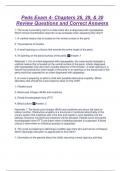Peds Exam 4- Chapters 26, 29, & 30
Review Questions and Correct Answers
1. The nurse is providing care to a male infant who is diagnosed with hypospadias.
Which clinical manifestation does the nurse anticipate when assessing this infant?
1. A urethral meatus that is located on the ventral surface of the penis
2. The presence of foreskin
3. A small opening or a fissure that extends the entire length of the penis
4. An opening on the dorsal surface of the penis ✅Answer: 1
Rationale 1: For an infant diagnosed with hypospadias, the nurse would anticipate a
urethral meatus that is located on the ventral surface of the penis. Infants diagnosed
with hypospadias may also have a partial absence of the foreskin. A small opening or a
fissure that extends the entire length of the penis or an opening on the dorsal side of the
penis would be expected for an infant diagnosed with epispadias.
2. A nurse is preparing to admit a child with possible obstructive uropathy. Which
laboratory test should the nurse expect to draw on this child?
1. Platelet count
2. Blood urea nitrogen (BUN) and creatinine
3. Partial thromboplastin time (PTT)
4. Blood culture ✅Answer: 2
Rationale 1: The blood urea nitrogen (BUN) and creatinine are serum lab tests for
kidney function. Obstructive uropathy is a structural or functional abnormality of the
urinary system that interferes with urine flow and results in urine backflow into the
kidneys; therefore, the BUN and creatinine will be elevated. Platelet count and partial
thromboplastin time (PTT) are drawn when a bleeding disorder is suspected. A blood
culture is done when an infectious process is suspected.
3. The nurse is preparing to discharge a toddler-age client who just had an orchiopexy.
Which discharge instruction is appropriate for this client?
1. Information to the parents about the child's resuming normal vigorous activities
,2. Discussion with the parents about the low incidence of testicular malignancy and no
further need for any follow-up
3. Explanation to the parents about the need for loose, nonrestrictive clothing
4. Reassurance to the parents that infertility is not a future risk ✅Answer: 3
Rationale 1: Orchiopexy is the surgical correction of cryptorchidism (failure of the testes
to descend into the scrotal sac). Discharge instructions should include information about
the need for loose, nonrestrictive clothing to avoid pressure on the postoperative site.
The risk of testicular cancer is 35 to 50 times greater in men with a history of
cryptorchidism. Long-term planning includes teaching the child to perform monthly
testicular examinations once puberty has been reached. Vigorous activities such as
straddling toys, riding bicycles, or rough play should be avoided for up to two weeks
following surgery to promote healing and prevent injury. A discussion of fertility and the
possible need for fertility testing is important, since cryptorchidism increases the risk of
infertility.
4. Which symptoms are characteristic of a preschool-age client who is diagnosed with a
urinary tract infection?
1. Foul-smelling urine, elevated blood pressure, and hematuria
2. Severe flank pain, nausea, headache
3. Headache, hematuria, vertigo
4. Urgency, dysuria, fever ✅Answer: 4
Rationale 1: Clinical manifestations of a urinary tract infection (UTI) in a preschool-age
client include fever, urgency, and dysuria. While hematuria may be present, there is no
elevated blood pressure, headache, or vertigo.
5. A child is admitted to the hospital unit with a diagnosis of minimal-change nephrotic
syndrome (MCNS). Which clinical manifestations does the nurse anticipate when
conducting the admission assessment?
1. Hematuria, bacteriuria, weight gain
2. Gross hematuria, albuminuria, fever
3. Massive proteinuria, hypoalbuminemia, edema
4. Hypertension, weight loss, proteinuria ✅Answer: 3
, Rationale 1: Nephrotic syndrome is an alteration in kidney function secondary to
increased glomerular basement membrane permeability to plasma protein. It is
characterized by massive proteinuria, hypoalbuminemia, and edema. While hematuria
and hypertension may be present, they are not pronounced. Gross hematuria and
hypertension are associated with glomerulonephritis. Bacteriuria and fever are
associated with a urinary tract infection. Because of the edema, a weight gain, not a
weight loss, would be seen.
6. A school-age client diagnosed with nephrotic syndrome is severely edematous. The
primary healthcare provider has placed the child on bed rest. Which nursing intervention
is a priority for this client?
1. Reposition the child every two hours.
2. Monitor BP every 30 minutes.
3. Encourage fluids.
4. Limit visitors. ✅Answer: 1
Rationale 1: A child with severe edema, on bed rest, is at risk for altered skin integrity.
To prevent skin breakdown, the child should be repositioned every two hours. Vital
signs are taken every four hours, fluids need to be monitored and should not be
encouraged, and the child needs social interaction, so visitors should not be limited.
7. A preschool-age client diagnosed with with nephrotic syndrome is placed on
prednisone for several weeks. Which teaching point is appropriate for the nurse to
include in the teaching plan for this client?
1. Never stop the medication suddenly.
2. This drug is taken once a week on Sunday.
3. The child should always take the medication at night before bed.
4. This drug should be taken with meals. ✅Answer: 1
Rationale 1: Prednisone, a corticosteroid with anti-inflammatory action, is frequently
used to treat nephrotic syndrome. It should never be stopped suddenly. The drug is
taken more than once a week and can be taken any time during the day, but should
remain on a constant schedule. Taking with food is always appropriate for most
medications, but it does not have to be with a meal.
8. A preschool-age client is diagnosed with acute glomerulonephritis and is admitted to
the hospital. Which nursing diagnosis is most appropriate for this client?




